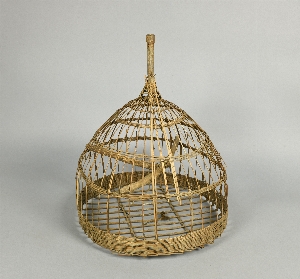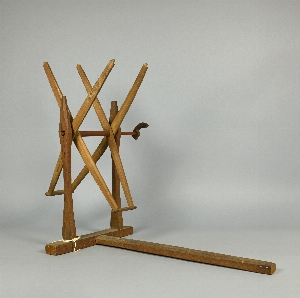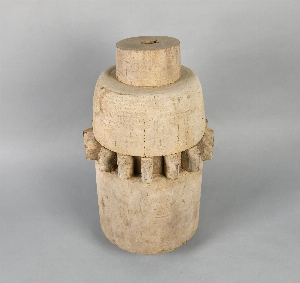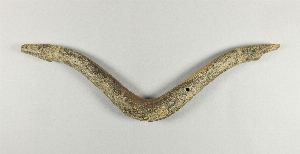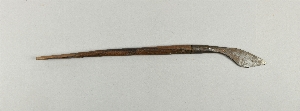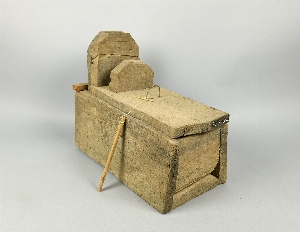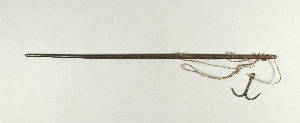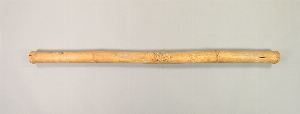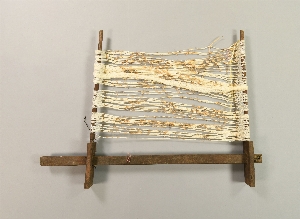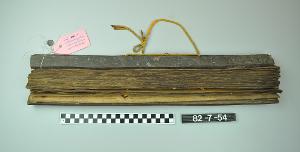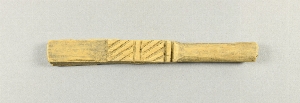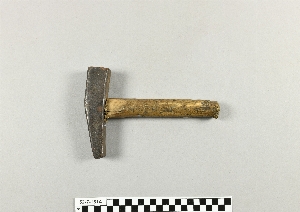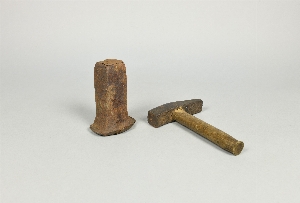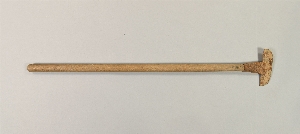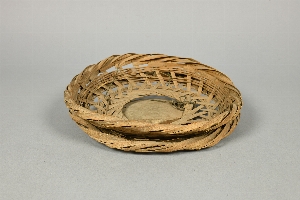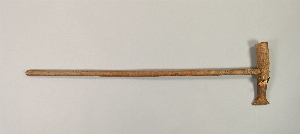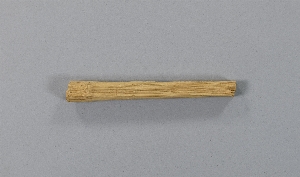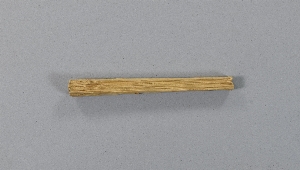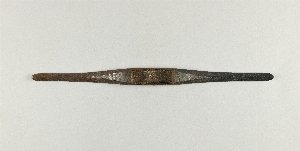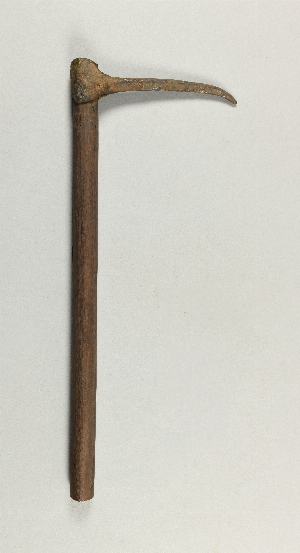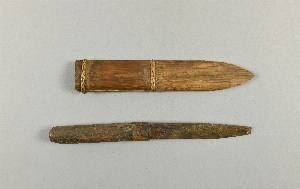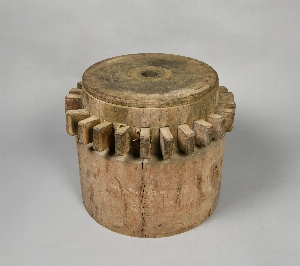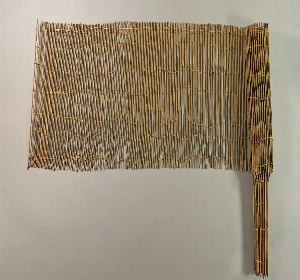Thai-Lao Ethnographic Collection
In 1981, Joyce White, who had been conducting field research in Thailand for 18 months in the village of Ban Chiang, received a telegram from the Penn Museum requesting that she make a collection of everyday items illustrative of traditional village life. Ban Chiang was the location for excavations by Penn Museum and the Thai Fine Arts Department in 1974 and 1975. White’s ethnobotanical research was part of the Penn Museum Ban Chiang Archaeological Project, and that work had prepared her well for the task.
Joyce had been working with a local farmer, Li Hirionatha, to collect and document traditional knowledge of plants in the region. Over the course of the final two months of that research, Joyce and Li meticulously put together a collection of representative objects of the area noting the name and function of each piece, as well as where it was purchased and when, and other data. The collection consists of examples of everything from ox carts and fishing traps to looms and ceramics.
In the summer of 2024, Thai-Isaan Material Culture Specialist, Nichanan Klangwichi, spent three months at the Penn Museum updating and expanding the cataloging of the collection. Object names and villages are now in both English and Thai. The description includes fuller cultural context and plant names for materials, as well as bibliographic references for further study.
Below you can explore the collection with various filters such as on material and function. To see, for example, all the objects used for fishing, click on the “Subject” filter on the lower left, then select “Fishing Equipment”.
- Object[216]
- no[216]
- asian[216]
- adze[2]
- axe[3]
- balance scale[1]
- basket[1]
- beam[13]
- bellows[2]
- bellows base[2]
- bellows pump[2]
- betel bowl base[1]
- betel box[2]
- betel masher[1]
- betel nut pounder[2]
- bird cage[1]
- bird trap[1]
- blacksmith's anvil[1]
- blacksmith's hammer[1]
- bowl[4]
- box[4]
- cart wheel[2]
- coconut grater[1]
- cocoon unraveller[3]
- cotton roller[1]
- cover[1]
- cowbell[1]
- crossbow[2]
- dagger[1]
- dagger sheath[1]
- digging stick[1]
- dipper[1]
- drill[1]
- dye material[2]
- elephant hook[1]
- farming tool[1]
- fish basket[1]
- fish container[1]
- fish fence[2]
- fish net[2]
- fish strainer[1]
- grub hoe[1]
- guitar[1]
- harness[2]
- harrow[1]
- hatchet[2]
- hoe[2]
- hook[1]
- iron[1]
- iron forging base[1]
- iron forging hammer[1]
- knife[5]
- knife sheath[1]
- lattice[2]
- lip balm holder[2]
- loom[2]
- loom part[45]
- loom rod[1]
- machete[1]
- manuscript[1]
- massage instrument[1]
- mat maker[2]
- mortar[2]
- mouth organ[2]
- paddle[1]
- part[3]
- peg[11]
- pellet bow[1]
- pestle[7]
- pillow[1]
- plate[1]
- plow yoke collar[1]
- plowshare[1]
- pole[4]
- post[8]
- potter's paddle[3]
- rat trap[1]
- rice basket[1]
- rice mill[2]
- rice mortar[1]
- rice turning board[1]
- rice winnower[1]
- rope making frame[2]
- seat[1]
- shuttle[4]
- sickle[2]
- silk unraveller[2]
- silk worm stand[1]
- skein winder[5]
- skein winder base[2]
- spindle[1]
- spinning wheel[2]
- spool[1]
- sugar mill cog[6]
- sugar mill part[3]
- sugar mill post[4]
- thread sorter[4]
- thread winder[2]
- tree trunk[2]
- water bucket[2]
- weaver's sword[3]
- wood sample[2]
- yoke[2]
- ban bong nuae[1]
- ban bun mi[29]
- ban chiang[32]
- ban don[4]
- ban dong yen[6]
- ban dun[1]
- ban kham or[2]
- ban kham phakkood[10]
- ban kham ta na[8]
- ban khon sawan[1]
- ban na di[1]
- ban non sao khwan[3]
- ban non sung[2]
- ban nong lat[2]
- ban nong mek[8]
- ban om kaeo[42]
- ban phon ngam[1]
- ban pu lu[10]
- ban pueai[7]
- ban sam kha[8]
- ban tha chuang[5]
- ban thung fon[3]
- ban tong[1]
- ban ya[2]
- burma[1]
- chaiyaphum[8]
- east of ban khon sawan[2]
- laos[1]
- pagan[1]
- pukendon[1]
- sakon nakhon[13]
- thailand[216]
- udon thani[202]
- udon thani (city)[4]
- ban bong nuae[1]
- ban bun mi[29]
- ban chiang[32]
- ban don[4]
- ban dong yen[6]
- ban dun[1]
- ban kham or[2]
- ban kham phakkood[10]
- ban kham ta na[1]
- ban khon sawan[3]
- ban na di[1]
- ban non sao khwan[3]
- ban non sung[2]
- ban nong lat[2]
- ban nong mek[8]
- ban om kaeo[42]
- ban phon ngam[1]
- ban pu lu[10]
- ban sam kha[8]
- ban tha chuang[5]
- ban thung fon[3]
- ban tong[1]
- ban ya[2]
- udon thani (city)[4]
- 18th century[1]
- 20th century[1]
- agricultural tools and equipment[12]
- animal husbandry tools and equipment[3]
- betel chewing tools and equipment[14]
- ceremonial object[1]
- clayworking tools and equipment[3]
- container[2]
- cotton production[4]
- cultivation equipment[2]
- cutting tool[7]
- documentary objects[1]
- fiberworking tools and equipment[4]
- fishing equipment[7]
- food processing tools and equipment[36]
- food service tools and equipment[2]
- household accessory[1]
- hunting equipment[3]
- lighting device[1]
- metalworking tools and equipment[11]
- musical tools and equipment[3]
- personal artifacts[2]
- religious text[1]
- rice production[18]
- silk production[7]
- smoking & recreational drug equipment[5]
- textileworking tools and equipment[80]
- tools and equipment[1]
- transportation artifacts[8]
- trapping equipment[2]
- unclassifiable artifacts[5]
- weapon blade[2]
- weights & measures tools and equipment[1]
- woodworking tools and equipment[6]
- bamboo[53]
- banana leaf threads[1]
- basketry[5]
- brass[3]
- clay[2]
- cloth[2]
- coconut shell[1]
- copper[2]
- cotton[3]
- cotton thread[1]
- gourd[3]
- insect nest glue[2]
- iron[28]
- mai bong[1]
- mai bueay[3]
- mai cham chaa[1]
- mai daeng[3]
- mai duu[15]
- mai jik[2]
- mai kadoon khook[1]
- mai kawk kan[1]
- mai khaaw[1]
- mai khaen khayawm[1]
- mai kung[6]
- mai maak lueam[2]
- mai makhaa[1]
- mai phan saad[7]
- mai rai[1]
- mai som kob[2]
- mai yung[4]
- metal[19]
- nails[2]
- namman yaang khii sii[1]
- nylon[3]
- palm leaf[1]
- raffia[1]
- rattan[7]
- reed (plant)[4]
- rope[4]
- steel[1]
- string[4]
- sugar palm fiber[1]
- textile[28]
- thread[1]
- twine[1]
- water buffalo horn[1]
- wicker[1]
- wire[1]
- wood[216]
- actual citation[4]
- type citation[43]
31 - 60 of 216 Records
